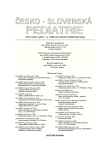Regional Difference in the Breastfeeding Rates at the Age of 6 Weeks, 3 and 6 Months in the Czech Republic from 2000 to 2006
Authors:
A. Mydlilová 1; J. Wiesnerová 2; A. Šípek 3
Authors‘ workplace:
Národní laktační centrum, Fakultní Thomayerova nemocnice, Praha
vedoucí MUDr. A. Mydlilová
1; Ústav zdravotnických informací a statistiky, Praha
ředitelka Mgr. V. Mazánková
2; Oddělení lékařské genetiky, Fakultní Thomayerova nemocnice, Praha
primář MUDr. V. Gregor
3
Published in:
Čes-slov Pediat 2009; 64 (10): 469-475.
Category:
Original Papers
Overview
Purpose:
To determine breastfeeding rates at the age of 6 weeks, 3 and 6 months in the whole Czech Republic from 2000 to 2006 and to identify regions with the lowest breastfeeding rates and regional changes in breastfeeding rates from 2000 to 2006.
Methods:
Data from 648 625 infants born from 2000 to 2006 were collected retrospectively from Annual reports PLPDD-A016 that have to be filled by every pediatrician. The means were calculated for the whole Czech Republic and separately for each region.
Results:
The average rates of exclusively breastfed infants at 6 weeks increased from 26.1% in 2000 to 50% in 2006, at 3 months from 26.1% in 2000 to 39.4% in 2006 and at 6 months from 10.5% in 2000 to 22.8% in 2006. The average rates of any breastfeeding at 6 weeks increased from 53.9% in 2000 to 79.3% in 2006, at 3 months from 47.9% in 2000 to 60.7% in 2006 and at 6 months from 23.8% in 2000 to 40.9% in 2006. The regions with the lowest breastfeeding rates (Jihočeský, Ústecký a Liberecký) and with the highest breastfeeding rates (Zlínský, Středočeský and Prague) were identified. The possible influences of various maternal age and education in particular regions on regional differences are discussed.
Conclusion:
The breastfeeding rates in the Czech Republic are slowly improving; however, only less than 1/3 of infants are breastfed at the age of 6 months. In breastfeeding support it is necessary to focus on regions with identified low breastfeeding rates.
Key words:
breastfeeding, exclusive breastfeeding
Sources
1. World Health Organization. Global Strategy on Infant and Young Child Feeding. 55th World Health Assembly. Geneva, Switzerland: World Health Organization, 2002.
2. Mydlilová A, Schneiderová D, Šípek A. Vliv některých faktorů na počet kojených dětí při propuštění z porodnice v letech 2000 až 2004. Čes.-slov. Pediat. 2008; 63(4): 182–191.
3. Mydlilová A, Šípek A, Vignerová J. Breastfeeding rates in Baby-friendly and non-Baby-friendly hospitals in the Czech Republic from 2000 to 2006. J. Hum. Lact. 2009; 25(1): 73–78.
4. Labbok M, Wardlaw T, Blanc A, et al. Trends in exclusive breastfeeding: Findings from the 1990s. J. Hum. Lact. 2006;22(3): 272–276.
5. Cattaneo A, Yngve A, Koletzko B, et al. Protection, promotion and support of Brest-feeding in Europe: current situation. Public Health Nutrition 2004;8(1): 39–46.
6. Scott JA, Binns CW, Oddy WH, et al. Predictors of breastfeeding duration: Evidence from a cohort study. Pediatrics 2006;117(4): 646–655.
7. Romeo SQ, Bernal R, Barbiero CH et al. A rapid ethnographic study of breastfeeding in the North and South of Italy. Int. Breastf. J. 2006;1: 14.
8. Riva E, Banderali G, Agostoni C, et al. Factors associated with initiation and duration of breastfeeding in Italy. Acta Pediatr. 1999;88: 411–415.
9. Li R, Darling N, Maurice E, et al. Breastfeeding rates in the United States by characteristics of the child, mother, or family: The 2002 National Immunization Survey. Pediatrics 2005;115 (1): 31–37.
10. Ludvigsson JF, Ludvigsson J. Socio-economic determinants, maternal smoking and coffee consumption, and exclusive breastfeeding in 10205 children. Acta Pediatr. 2005;94: 1310–1319.
11. Merewood A, Mehta SD, Chamberlain LB, et al. Breastfeeding rates in US Baby-Friendly hospitals: Results of a National Survey. Pediatrics 2005;116(3): 628–634.
12. Lande B, Andersen LF, Baerug A, et al. Infant feeding practices and associated factors in the first six months of life: The Norwegian Infant Nutrition Survey. Acta Pediatr. 2003;92: 152–161.
Labels
Neonatology Paediatrics General practitioner for children and adolescentsArticle was published in
Czech-Slovak Pediatrics

2009 Issue 10
Most read in this issue
- Periodic Fever Syndromes
- Trichophyton verrucosum as an Unusual Cause of Wound Infection in the Hairy Part of Head
- Alcohol Use in Czech Adolescents
- Experience of Young School Aged Children with Legal Drugs
